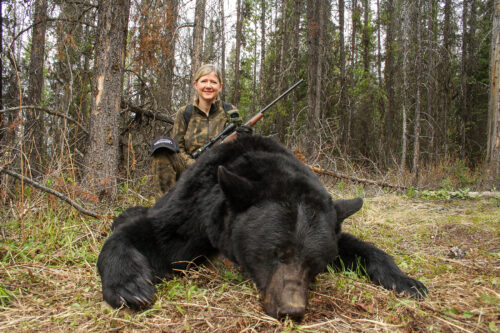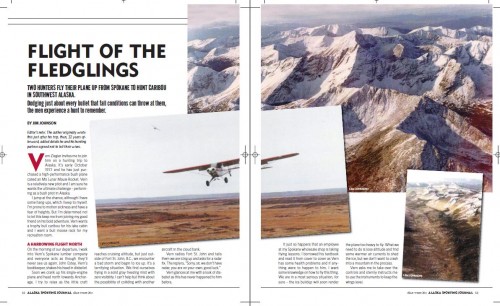
Encounters With Big, Bad Alaska Bears
The following appears in the March issue of Alaska Sporting Journal:

FIRST OF TWO PARTS
BY SCOTT HAUGEN
Bending down, the beam of my flashlight illuminated the tiny, round indentations left by a man on his knees as he made his way atop the crusted snow.
Blood from his fingers was scraped across the ice crystals. A strand of long hair attached to a piece of scalp frozen to the snow flailed in the wind; that’s where the polar bear had again grabbed him.
I was 75 yards into the solo tracking job. By this point the man had lost nearly half his scalp, which I’d found scattered atop the snow. He’d also wriggled from his bite-mark-riddled jacket. Feeling hot and confined, I removed my down facemask, despite the minus-42-degree temperature on this December morning in Alaska’s high Arctic.
As I continued the search, more blood and hair made it easy to follow. The attack had taken place more than an hour prior from when I got the call to help, at 4 a.m. With so much time having passed since then, my biggest fear was that the man would be killed by the bear or die of exposure.
My pace quickened as I descended a valley created by two towering snowdrifts, each over 50 feet high. It was at the bottom where I found the body, over half of it having been devoured by the bear. I had no idea who the man was when my search began. The bear had eaten so much of the body, I still had no clue.
Shining my flashlight across the pack ice of the Arctic Ocean, I caught a glimpse of the bear’s glowing eyes. It was in no hurry, and I quickened my walk to close the distance. At 20 yards, I wasn’t sure if my pre-1964 Model 70 .30-06 Winchester would fire or not. It did, and with one shot the 220-grain handload ended the horrific ordeal.
The year was 1990, and this event took place in the tiny village where Tiffany and I worked as school teachers at the time. It marked the first of many bear encounters I’d have in Alaska over the next three decades.

MALE POLAR BEARS ARE active all winter as they follow open leads on the Arctic Ocean in search of seals and walruses. When these leads in the pack ice occur near coastal villages, polar bears often wander into town looking for easy food. It happened in Wales – a community located north of Nome – this past winter, the first documented case of a polar bear killing a human since my encounter in 1990. And there have been other moments with these predators of the Alaskan Arctic.
One Christmas Day, a gunshot echoed from a neighbor’s house in Point Lay. Then my phone rang. “Get over here, a polar bear’s been trying to break into our house for the past hour and I just shot at it through the front door as it was breaking it down!” urged my neighbor.
Carrying my flashlight and .30-06, I went to the front of the man’s house and saw a blood trail leading away. The front door, made of thick metal to withstand the harsh Arctic conditions, was bent at a 45-degree angle, the top hinge having been busted from the frame, and there was a single .45-70 hole through the center. I entered the house through another door. That’s when I found broken glass on the kitchen floor from where the bear had tried getting into the house through a window it shattered. The man’s wife stopped the attack with a skillet to the bear’s nose. We followed the blood trail and found the bear dead.
Another time, in January, I heard the neighbor on the other side of me shoot multiple times. I opened my door to see him beneath the glowing street lights, clad in his underwear, firing through cracks in his elevated porch between his feet. A massive polar bear was below him. The bear had killed the man’s dog that was housed there, and he killed the bear, a specimen that measured over 10 feet from nose to tail.
Two months of total darkness consumes the Arctic in winter, making every polar bear encounter I had nerve- wracking, especially amid temperatures that always dropped well below zero. There were more encounters, too – many more.

OVER THE YEARS I’VE been on multiple brown bear and inland grizzly hunts, and I love spending time on the upper Alaska Peninsula. But one hunt based out of the tiny village of Egegik stands out. The excitement began to build upon my arrival.
Once commercial fishermen leave the town in late summer, brown bears move in to scavenge. I walked through part of the town on the north side of the bay and found house after house that had been broken into by hungry brown bears. Bear boards – sheets of plywood with long screws drilled through them every few inches – were placed outside most windows and doorways. They didn’t stop the bears. Bloody footprints from the holes in their feet made by the bear boards they walked on to access the homes told the story.
Some bears plowed through plate-glass windows, demolishing the insides of houses to get every ounce of food. Other bears busted down doors to gain access, while some simply ripped the siding off and walked in. Though only a couple people occupied this side of town in late fall, the bears were nocturnal and hard to deal with.
I once killed a massive brown bear 7 miles from Egegik. We spotted it early in the morning, but the wind was never right to make a move. Finally, 11 hours later I killed the brute (there’s a lot of daylight this far north in the month of May). The bear squared 10 feet, 9 inches, and was 23 years old. It had many scars and a couple very old bullet wounds, making me wonder if this was one of the marauding bears the locals had shot at in year’s past.
A few years later in the same area, I was charged by a temperamental brown bear, one that came close; too close. ASJ
Editor’s note: Stay tuned for next month’s issue, in which Scott Haugen shares more bear encounters. Scott is a full-time author. Learn more at scotthaugen.com and follow his adventures on Instagram.
Sidebar
TRY THIS CORNED GAME MEAT SAMMY


BY TIFFANY HAUGEN
Now is a good time to dig through the freezer and make sure none of that great-eating big game meat from last fall gets shoved to the back and forgotten.
Corning big game – whether it be moose, caribou, deer or even bear – not only adds to the flavor and textures of the meat, it offers a break from making any cooking decisions for three to 10 days.
While Saint Patrick’s Day celebrations this month traditionally bring corned beef to mind, corning wild game of any kind is a wonderful addition to the table year-round. Corned venison and corned waterfowl may be recipes you’ve tried, and if you haven’t, you should.
Due to the preservatives in Morton’s Tender Quick seasoning or a pink salt cure, meat can brine for an extended period of time. This means you can cook up a bit of your quarry, toss some in the brine for the following week and freeze the rest. This recipe works with any big game and waterfowl.
3 to 4 pounds meat of choice
1?4 cup boiling water
6 cups ice-cold water
3 tablespoons Morton’s Tender Quick seasoning
2 tablespoons brown sugar
2 tablespoons pickling spices
1 tablespoon granulated garlic
1 tablespoon granulated onion
1 tablespoon black pepper
In a large brining container, mix dry ingredients with boiling water and stir to dissolve. Add ice-cold water and stir well. Add the desired meat to the brine. Be sure all meat is submerged in the brine. Refrigerate for three to 10 days.
Corned meat can be smoked, grilled, sliced and pan-fried, pressure cooked (high pressure for 30 minutes) or slow cooked (three to five hours or until tender). Even a batch of goose or swan wings, legs and thighs can be pressure cooked (high pressure for 50 minutes) or slow cooked (five to six hours) until meat can be removed from bones easily.
Shred or slice corned meat and serve in a traditional Reuben sandwich, fried into hash or served beside eggs (any style) for breakfast. Once corned, the serving options are plenty.
Editor’s Note: For signed copies of Tiffany Haugen’s popular book, Cooking Big Game, go to scotthaugen.com for this and other titles.



